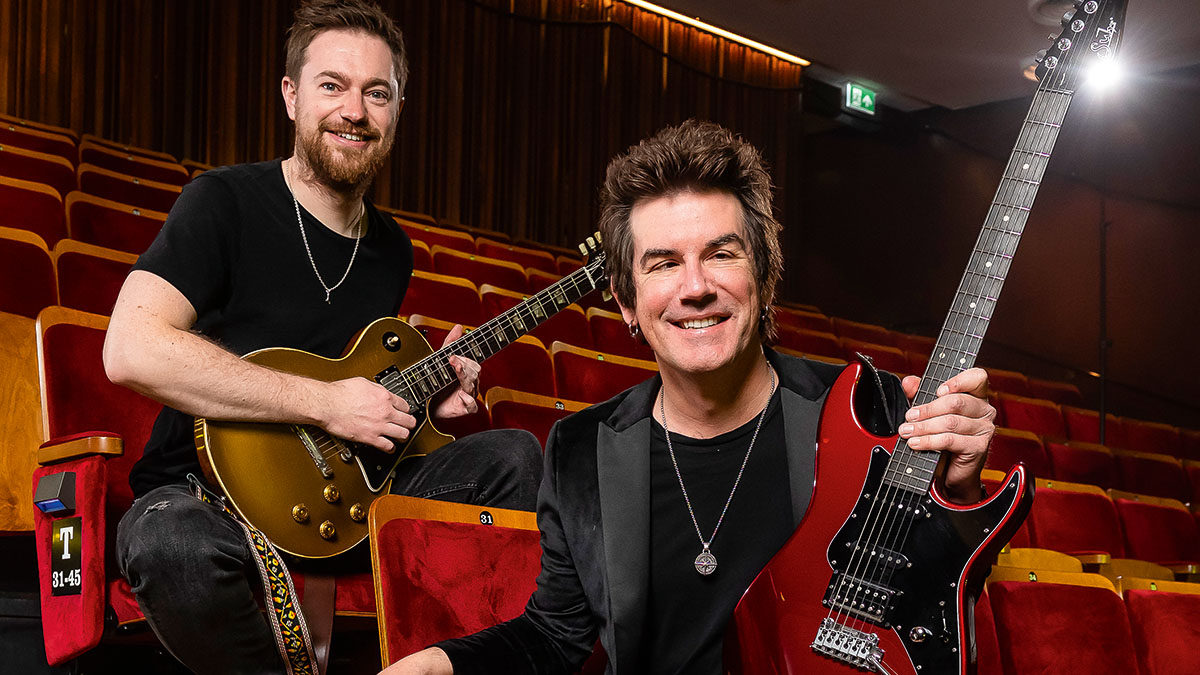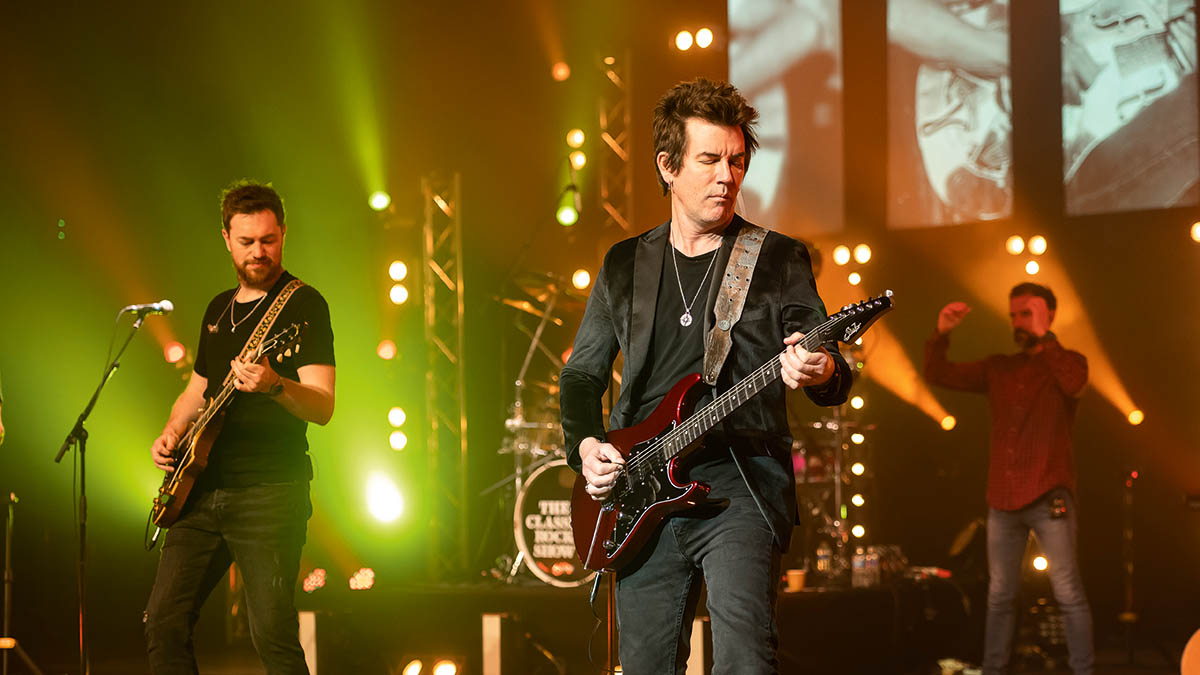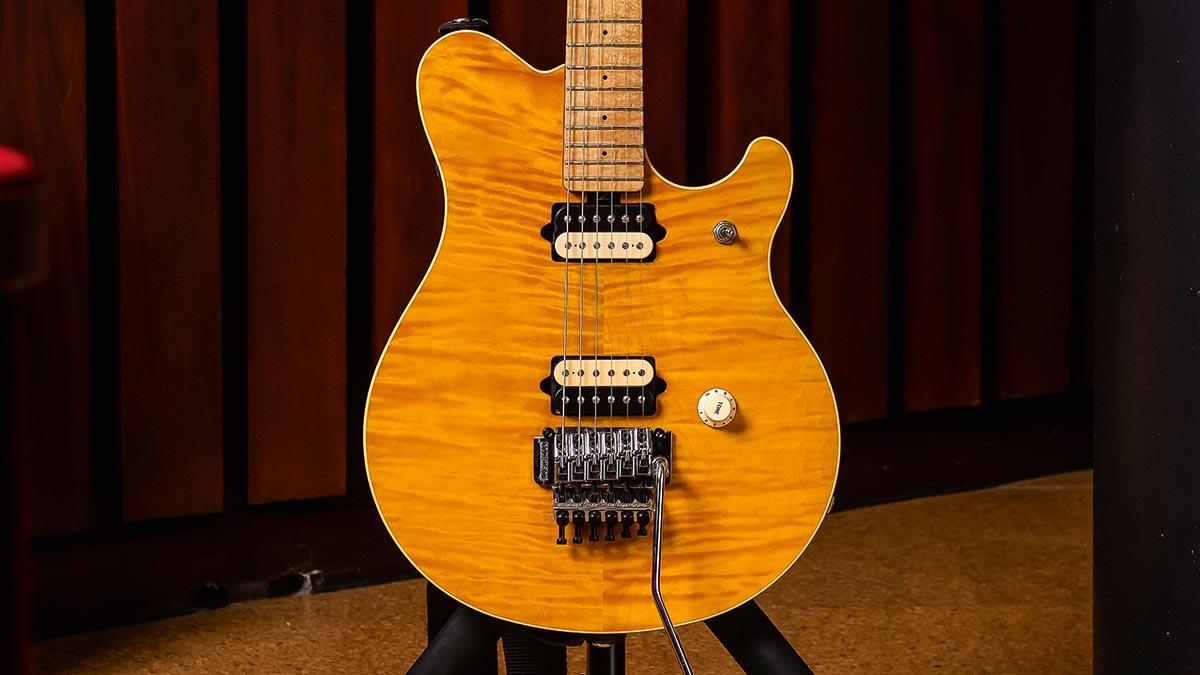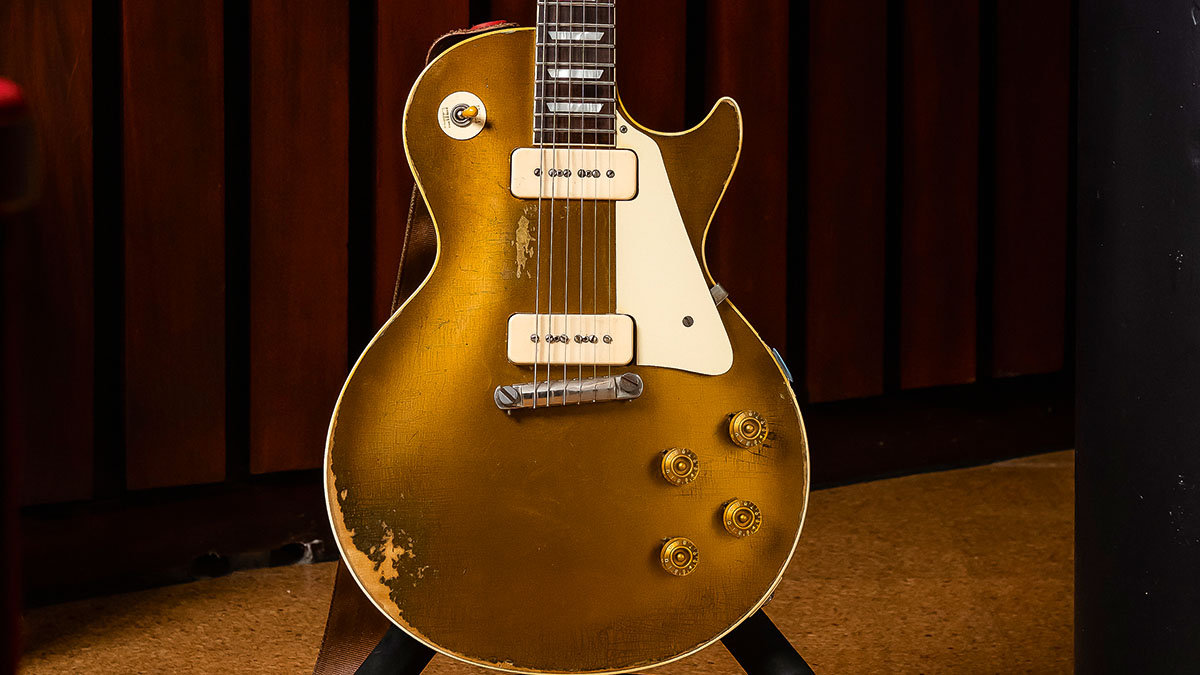
“I want it to be loud, a little out of control,” says Pete Thorn, in his urbane Los Angeles drawl. “There needs to be some feedback.” Even if you’ve never watched any of Pete’s highly regarded YouTube videos exploring the world of cutting-edge guitar gear, you’ve almost certainly heard his playing before. He’s been a first-call session and sideman for huge acts such as the Eagles, Chris Cornell and Alicia Keys.
Now, however, he’s reflecting on what it takes to recreate rock’s greatest hits on stage without the music becoming too predictable or sanitised. “There’s got to be some balls…” agrees James Cole, with refreshing directness.
James is Pete’s musical partner in the noble (and reassuringly loud) enterprise that is The Classic Rock Show. A veteran racing driver who has competed in Formula 2 and British Touring Car Championships, James has been the musical director of The Classic Rock Show since 2015.
Apart from during the pandemic, the show has been on the road every year since 2012, packing out auditoriums up and down the country. Covering everything from Zeppelin to the Eagles and Van Halen over the course of two majestic sets, the eight-strong band has its work cut out, but, for them, it’s all part of the fun.
Today, we’ve joined James and Pete in Eastbourne on the South Coast, which was once the scene of pitched battles between mods and rockers. They’re performing here tonight, but with soundcheck not quite ready to begin, they have a bit of time spare to talk about music and show us some of the beautiful guitars they’ve brought on tour.
To kick things off, we ask them about a challenge that all bands that cover classic material face… how slavishly faithful to the original recordings do you need to be?
“If you’re gonna play Another Brick In The Wall, that solo has to be right,” James reflects, “because it’s so iconic. And part of that [quest for accuracy] – just speaking for myself – is to prove that I can do it. But then once you’ve done that, then it’s like, okay, well, at the end of the day, yes, we’re doing it for ourselves as musicians, but it’s really about the 1,000 people who have paid to come and see us - so it’s what makes them happy. And what makes them go, ‘Wow’ at the end of the night.
“In the early days of The Classic Rock Show and other shows I’ve performed with, there’s been so much focus on playing it right, rather than performing and putting on a show for the audience. And I think my focus has moved – not to ‘less detail’ but to focusing on what’s important,” he says.
Classic tone
For James and Pete, a big part of getting the spirit of the music right, as well as the detail, is using real tube amps, rather than digital modelling. That means the band’s rigs have to be a blend of old-school valve tone and sophisticated effects and routing gear to ensure they have the flexibility to cover a wide-ranging setlist. But despite the technical demands of making analogue kit perform in a programmable way, both Pete and James believe the sonic payoff is worth it.
“We had a friend who used to play in the show, Bobby Harrison, who joined us on stage last night,” James says. “The three of us did Free Bird and Bobby’s [recently] been doing shows with Cliff Richard, using Kempers and everything. But he just went, ‘Wow! Playing through amps again!’”
Pete Thorn uses a two-amp rig featuring a prototype Suhr SL68 head that is effectively a heavily modded ‘Plexi’ plus a 4x12 cabinet with Greenbacks in the top and Vintage 30s in the bottom for his dirty and crunch tones. The SL68 is, in fact, a prototype head that has some unique tricks up its sleeve.

Spotting some non-standard switches on its control panel, we ask Pete what everything does.
“These are little mods that John [Suhr] did for me,” he says before smiling. “So he’s gonna hate me talking about this because he’ll get requests for these, I’m sure. But basically this [first one is a] switchable Bright. So it just goes between Off and then two different Bright values.
“And I use it in the 4,700pF bright value [mode], which is like what Marshall was doing from ’68 to about ’72. It’s a really big, bright cap. That kind of makes it a one-trick pony – but it’s an amazing trick. When you get the amp up to about 7 or 7.5, it’s just got the teeth because of the bright cap and it sounds great.
“The next one is a switchable value for the mid-pot… Eddie Van Halen’s amp had kind of an odd mid-pot value, it just kind of makes it sound a little more open, a little more gain-y, you know, but it’s very subtle. And then the other one is for a switchable Fat Cap in the front-end. It sounds a little fuller, bigger or a little more ‘soft-Marshall’.”
Off to one side of the SL68, Pete also has a Suhr Bella combo set aside for the clean work. His pedalboard features analogue and digital effects and is routed to serve both amps with the separate groups of effects that best suit them.
He also uses a high-end Shure Axient wireless system for freedom of movement on stage, which he describes as “just flawless”. Plus voltage-regulation gear ensures his amps get exactly the power they need, as venue power supplies can wander up to 10 volts above and below where they ought to be, which can hurt amp performance and reliability.
James, meanwhile, pairs a 633 Engineering head with a Bartel cabinet, using a high-end Axe-Fx unit by Fractal Audio to provide his effects.
“I run the [633] Classic 45, which is a JTM45-style head, at 20 watts, but it’s amazingly loud. With the headroom switch [engaged], it’s amazing how loud 20 watts can be. And we’ve got that running into a Bartel 2x12, which has got Alnico Fane [loudspeakers] in it.
“It’s a one-channel amp, which I’m running in a four-cable method with the Axe-Fx. And I’m using the Axe-Fx purely for pre- and post-effects. The amp is cranked so, apart from three sounds where I require a boost, all the overdrive is coming from the amp.”
Eddie’s influence
With these rigs as the core of their sound, the rest of Pete and James’s tonal variation comes from their guitars, which are a stunning selection of custom instruments and vintage pieces.
Lest this sound like a bad case of high-end Gear Acquisition Syndrome, the guitars chosen by both men typically have either a close personal connection or an interesting backstory. Pete Thorn is a lifelong fan of Van Halen and, as such, the presence of an original ’90s Ernie Ball Music Man EVH signature model shouldn’t be a surprise.
“I mean, the thing about this guitar is I have this really vivid memory of it,” Pete reflects. “Seeing it in a magazine ad for the first time… I mean, I was a big Eddie Van Halen fan and we were used to seeing him with the ‘Stripe’ guitars, first his Frankenstein, then the Kramer. And then this… it was like, ‘What the heck is that?’
“Because it looked like a Tele body shape a little bit and had a neck pickup and it was a flame-top. And it was like, ‘God, it’s so different.’ But it was one of those things where I think, over time, a year or two passes, and we all got used to it.

“It’s interesting to me because the pickup in the Kramer was evidently what the reference was for [the pickups on the first Ernie Ball signature guitar] – kind of, ‘Take a look at that and then let’s try and get something close to that for the bridge pickup in these.’ And DiMarzio ended up winding a whole bunch of different prototype pickups for it.
“I think legend has it that Steve Lukather was up there, and Eddie was like, ‘I don’t know which one I like best out of the last two [prototypes]… why don’t you pick?’ Supposedly, Steve was the one that said, ‘I like this one.’ So Eddie Van Halen was like, ‘All right, let’s go with that one.’ And so the pickups in the guitar are totally unique to these guitars. DiMarzio won’t make them as an aftermarket. So it’s a unique pickup that has a really cool sound.”
Pete says he sought an original example of this model for quite a while before one arrived by a striking act of generosity from a stranger.
“I’ve always wanted one of these and I’d look occasionally for them, to find one. And I’d often thought about buying one because it was part of my childhood. But then a fellow named Simon Legg, who’s a fan of The Classic Rock Show, approached me about this guitar, saying that he’d bought one on Denmark Street around 1993. He’d kept the guitar under the bed. He played a little bit, but not a lot, and he was just aware from YouTube what a huge Van Halen fan I am. I guess there’s just a part of him that wanted to see it played, probably.
I was a big Eddie Van Halen fan and we were used to seeing him with the ‘Stripe’ guitars, first his Frankenstein, then the Kramer. And then this… it was like, ‘What the heck is that?’
Pete Thorn
“So he said, ‘I want you to have this guitar.’ It was so sweet, coming from a stranger, and he was there with his wife – they literally found me round by the backstage door – and his wife said, ‘He’s been looking for you for six months to try to talk to you about this guitar.’ I didn’t know what to say at first. So I said, ‘Look, I can’t take this guitar from you without doing something at least, in a similar spirit and in your name. I’ll make a donation to Mr Holland’s Opus [Foundation],’ which is a music education charity that Eddie Van Halen supported.”
Mighty Morgans
Like Pete’s, many of the guitars that James has taken on tour have a deeper story than might first be apparent.
When we ask why he had brought two Goldtops, James explains that while the humbucker-equipped ’57 was a vintage original, the second Goldtop – seemingly a completely authentic ’54 model with twin P-90s – was, in fact, the work of Terry Morgan, a hugely talented home luthier whose hand-built guitars were not mere ‘copies’ of vintage Gibsons but breathtakingly authentic doppelgangers.

“Terry Morgan was from just outside of Birmingham and he built Les Pauls in his garage,” James explains of Morgan’s legacy as a luthier. “He was the loveliest man, who died in [April] 2020. We think there are between 70 and 90 Les Pauls out there that he did. My one is a [replica of a] ’54 Goldtop and I’ve had very well-known luthiers tell me this is a real one and swear to me that there’s no way this can be a replica,” he says.
Terry Morgan was from just outside of Birmingham and he built Les Pauls in his garage... I’ve had very well-known luthiers tell me this is a real one and swear to me that there’s no way this can be a replica
James Cole
“Terry was a factory engineer who worked for Chubb,” James continues. “He’d always wanted a [classic vintage] electric guitar but couldn’t afford one, so he started to build them. But then he was made redundant in the early 2000s and he actually got some money and bought a ’54, for probably a few grand back then.
“So he used that as his reference for all these guitars. There’s an argument that his most accurate guitars are the ones with P-90s and with the low-logos [on the headstock] because that was his reference.”
Even with an original ’57 Goldtop ready to hand, the ’54-style Terry Morgan has become a go-to guitar for The Classic Rock Show.
“This guitar didn’t get used very much at the beginning of the tour,” James explains. “But in the last third of this tour, I’ve just wanted to use this one. I don’t know why, or what’s changed in me. But I started using this on Free Bird, which I’d never done before and it’s my favourite guitar now.”
Jimmy Page’s playing was like a stream of consciousness – it was about freedom of ideas. He didn’t care about things like mistakes
Compared with the PAF-powered 1957 model, he says the Terry Morgan guitar’s P-90s offer a broader spectrum of tones, especially if you make full use of the controls.
“When you turn it down, it feels like it has a lot more detail. It cleans up nicer than the ’57,” James says. “I’m using the tone control a lot more to get different sounds, especially when I’m playing slide because it’s so bright. You really have to dial the tone down in Free Bird, just try to get it to mellow out and warm up.”
James adds that the Goldtop and his S-style Suhr now form the main go-to guitars used for the show, though he’s brought quite a few other interesting electrics with him for use on particular tracks.
Learn to Burn
Of course, even the best guitars would be nothing without a skilled musician, and in the case of The Classic Rock Show those skills go beyond simple musicianship, extending into the realm of how to interpret and imitate the hallmark licks of some of the greatest guitarists who ever put pick to string. Has learning the work of so many iconic players changed Pete’s perspective on any of them?
“I’ve never learned a lot of Blackmore stuff before, but learning Burn for this tour really made me pay attention to what he’s doing rhythm guitar-wise and everything,” Pete reflects. “He’s such a unique, amazing guitar player. His phrasing is so cool, he just played with so much fire… So learning Burn was really amazing.”
However, Pete says that one player in particular teaches the invaluable lesson that it’s not always how precisely you play something but the spirit you bring to it.
“Jimmy Page’s playing was like a stream of consciousness – it was about freedom of ideas. He didn’t care about things like mistakes, I don’t think,” Pete reflects. “Like when you watch some of his solos, especially live, it’s really magical – he’s the ultimate guy to listen to and try to absorb if you’re uptight about your playing and worried about making mistakes… Because that doesn’t exist in his world. It’s all cool.
“It’s a really appealing sound because it’s so human. That and the fact that he doesn’t choke. He might make an error or do something that’s not technically correct. But he never chokes – he always moves on to the next thing. And that’s part of his sound and it’s the beauty of his playing. It’s so magical and so rock ’n’ roll, in a way.”
When performing such classic material, if you can strike the golden balance between delivering a tight performance and making sparks fly with sheer energy and exuberance, it has a really special effect on people, Pete adds.
“A guy came up to me the other night – he leaned over the table at the meet-and-greet afterwards and he goes, ‘I’m 75 years old and you guys just made me feel like I’m 25.’ That’s great. That is the coolest thing.”







